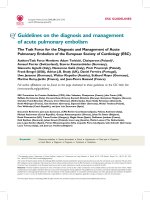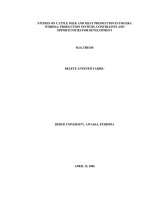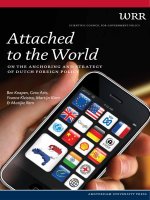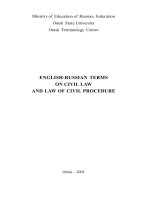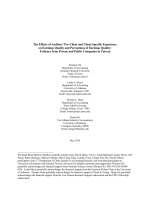Studies on occurrence, antibiogram and decontamination of Salmonella enterica in table eggs
Bạn đang xem bản rút gọn của tài liệu. Xem và tải ngay bản đầy đủ của tài liệu tại đây (378.93 KB, 13 trang )
Int.J.Curr.Microbiol.App.Sci (2017) 6(3): 2163-2175
International Journal of Current Microbiology and Applied Sciences
ISSN: 2319-7706 Volume 6 Number 3 (2017) pp. 2163-2175
Journal homepage:
Original Research Article
/>
Studies on Occurrence, Antibiogram and Decontamination
of Salmonella enterica in Table Eggs
C.O. Vinayananda1*, Mohamed Nadeem Fairoze1, C.B. Madhavaprasad2,
S.M. Byre Gowda3, C.S. Nagaraj4 and Nagappa Karabasanavar2
1
Department of Livestock Products and Technology, Veterinary College, Bengaluru-24, India
2
Department of Veterinary Public Health and Epidemiology, Veterinary College,
Shivamogga-04, India
3
IAH&VB, Hebbal, Bengaluru -24, India
4
AICRP on Poultry (Meat), Veterinary College, Hebbal, Bengaluru-24, India
*Corresponding author
ABSTRACT
Keywords
Occurrence;
Salmonella; eggs;
isolation; PCR;
antibiotics,
decontamination.
Article Info
Accepted:
20 February 2017
Available Online:
10 March 2017
Salmonellosis is one of the major leading foodborne zoonotic diseases reported
worldwide, poultry and poultry products including table eggs were reported as the
most important source for foodborne outbreaks in humans. The present study was
designed to determine and compare the occurrence of Salmonella serovars by
cultural and molecular (PCR) methods in processed, unprocessed and desi table
eggs available in the markets, resistance pattern of isolates for commonly used
antibiotics and decontamination of table eggs using chlorine and peracetic acid.
The results of present study revealed that occurrence of Sal. Enteric was found to
be 5.95 and 9.52 per cent by cultural and PCR method, respectively.Among the
isolates obtained, 3.57 per cent was found to be S. enteritidis and 2.38 per cent of
was S. typhimurium serotypes. The occurrence of S. enterica was found to be
2.08, 8.33 and 16.67 per cent in processed, unprocessed and desi table eggs,
respectively. The MAR indices for all five isolates Salmonella enterica was
0.2.Considering the reduction of TVC and Salmonella counts from the table egg
surface after sanitation, 100 ppm of per acetic acid (PAA) as a sanitizer was
comparatively effective than 200 ppm of chlorine (CL). Higher occurrence of
Salmonella species in the egg is of great public health concern. The study further
reinforces the necessity of improving the table eggs before it reaches the
consumer.
Introduction
Eggs are one of the economical nutritious
food items from the livestock and they form
an important part of the routine human diet.
However, good qualities of nutrients in eggs
offer the suitable environment to the
microbial proliferation. Eggs can be
contaminated or infected horizontally
(through
the
shell)
or
vertically
(transovarially), that may become potential
source of foodborne diseases in humans
(Martelli and Davies, 2011). Some
2163
Int.J.Curr.Microbiol.App.Sci (2017) 6(3): 2163-2175
pathogens like Salmonella, Escherichia coli,
Camphylobacter spp and enterococcci may
vertical transmitted (Sreenivasaiah, 2006).
Others sources of contamination are through
poultry workers, houses or cage, handling
during transportation and marketing. Among
the egg borne disease Salmonellosis is a
major
leading
disease
worldwide.
Salmonella
enteritidis
and Salmonella
typhimurium are the two most important
serotypes of Salmonella transmitted from
animals to human beings. Along with the
gastroenteritis they also cause extra
intestinal diseases like pleural empyema,
meningitis, splenic abscess, meningitis,
pleural
effusion
and
osteomyelitis
(Sudhaharan et al., 2014). Salmonella
enterica is a Gram-negative rod-shaped non
spore-forming bacterium (Pui et al., 2011).
There are around 2,500 known Salmonellae
serotypes have been documented of which
209 serovars were reported in India
(Rahman, 2002). Most commonly used
technique for Salmonella detection is the
conventional or cultural technique and
serological tests which are time consuming
and labor intensive. Alternatively, PCR
technology is employed which is a rapid
method with high sensitivity and specificity.
wall; it interferes with sulfhydril containing
enzymes of glucose metabolism thereby
leading to death of bacteria (Banwart, 1979).
Similarly per acetic acid also has shown better
effect in reducing the bacterial load on food
material and also has effective antimicrobial
activity in presence of organic matter
compared to chlorine (Cruz et al., 2007). Per
acetic acid is most commonly used in food
processing and handling, sanitizer for food
contact surfaces and as a disinfectant for
fruits, vegetables, meats, and eggs. It is
approved by FDA for use as an indirect food
additive (FDA, 2005). So, in the present study
peracetic acid is compared with the efficacy
chlorine against decontamination of table
eggs inoculated with the Salmonella
Typhimurim isolates.
In order to achieve the objective of food
safety in modern egg production and
processing, sanitization of eggs has become a
common practice. Several sanitizers are used
for this purpose, such as chlorine (Favier et
al., 2001), hydrogen peroxide (Padron, 1995);
electrolyzed water (Deza et al., 2003; David
et al., 2006; Subrota et al., 2012), UV
radiation (Kuo et al., 1997), pulsed light,
ozone (Whistler and Sheldon, 1988); gaseous
plasma (Luigi et al, 2010) etc., keeping
relative merits and limitations in view,
chlorine has emerged as one of the best
sanitizers used for egg sanitization (Favier et
al., 2001). Chlorine exerts its germicidal
property by penetrating into the bacterial cell
Table eggs available in the Indian markets
were from commercial layer farms and
poultry reared in backyard. Portion of eggs
from commercial or integrated layer farms
which layers are processed, packed and
marketed under different brand names
(processed) and maximum portion of eggs
are marketed through wholesalers/retailers
without any brand names (unprocessed).
Therefore, in the present study an attempt
has been made to determine the occurrence
of Salmonella serotypes by cultural and PCR
methods in the different groups table eggs,
antimicrobial resistance pattern of the
isolates and comparison of efficacy of PAA
(100ppm) with the CL (200ppm) for surface
decontamination of table eggs.
Materials and Methods
A total of 840 table egg samples were
collected from retail markets of selected
districts from Karnataka, India. The samples
were collected in a sterile plastic bag and
immediately transported to the laboratory. In
the present study eggs were categorized into 3
groups, which comprised of processed (480
2164
Int.J.Curr.Microbiol.App.Sci (2017) 6(3): 2163-2175
eggs of 4 different brands- 120 eggs from
each brand), unprocessed (240 eggs) and desi
eggs (120 eggs). All these egg samples (10
eggs per sample) were analysed for
occurrence of Salmonella enterica in egg
contents. The samples were collected and
analysed at four occasions with an interval of
15 days.
denaturation step for 1min followed by 35
cycles, with each cycle consisting of 1min at
94°C for denaturation, 1 min at64 °C for
primer annealing, 0.5 min at 72°C for strand
elongation and the final cycle at 72°C for 7
min.. PCR products were visualized
following electrophoresis through 1.5%
agarose gels stained with ethidium bromide.
Preparation of sample
Electrophoresis
Ten eggs were selected from each batch and
egg surface was sterilized by using 70%
ethanol. Then the eggs were broken into a
sterile polythene bag. The bags were
subjected to homogenization in stomacher
(BAG MIXER®, Interscience) for 2 min to
obtain a uniform homogenate.
Agarose gel (1.5%) was prepared by heating
molecular biology grade agarose in 1 X TAE
(Tris Acetate EDTA) buffer so as to dissolve
it completely. After cooling to about 50 °C,
ethidium bromide (C21H20BrN3) was added
to a final concentration of 1 μg/mL. Molten
agarose was then poured into the gel-casting
unit
and
kept
undisturbed.
After
solidification, the comb was removed from
the gel. The set gel along with gel-casting
unit was submerged in electrophoresis buffer
(TAE, 1X). About 4 μl of PCR product was
mixed with 1 μl of gel loading dye-6X (10
mMTris-HCl (pH 7.6) 0.03% bromophenol
blue, 0.03% xylene, cyanol FF, 60% glycerol
60 mM EDTA) and loaded into the wells
using
long
micro
pipette
tips.
Simultaneously
100
bp/50bp
DNA
molecular weight markers were also loaded
in one of the wells and electrophoresis was
performed at 70 Volts. The progress of
mobility was monitored by viewing
migration of the dye front. After
electrophoresis, the gel was visualized under
UV trans-illuminator and gel image was
photographed.
Occurrence of Salmonella enteric by
cultural methods
Standard method of isolation of Salmonella
i.e. ISO 6579:2002 was followed in this
study. The isolation step involved four
stages,
non-selective
pre-enrichment
(buffered peptone water -BPW), selective
enrichment (Rappaport-Vassiliadis broth),
selective
plating
(Xylose
Lysine
Deoxycholate-XLD) and confirmation of
Salmonella
suspected
isolates
by
morphology, motility, biochemical tests and
for molecular characterization of isolates,
DNA was extracted in the present study by
Snap-chill method (Zahrei et al., 2005)
followed by determination of virulence
markers based on specific amplification of
invA gene by polymerase chain reaction
(PCR) (Rahn et al., 1992). The nucleotide
sequences of the forward and reverse
amplimers were 5'-GTG AAA TTA TCG
CCA CGT TCG GGC AA -3' and 5'-TCA
TCG CAC CGT CAA AGG AAC C -3',
respectively with amplicon size of 284 bp.
Samples were amplified with temperature
conditions consisted of an initial 95°C
Serotyping of Salmonella enterica
Sal.enterica isolates that showed positive
reactions in biochemical and sugar
fermentation tests were further employed for
serotyping. All the Sal. entericisolates were
sent to National Salmonella and Escherichia
Centre, Central Research Institute, Kasauli
2165
Int.J.Curr.Microbiol.App.Sci (2017) 6(3): 2163-2175
(Himachal Pradesh) for serotyping.
on table eggs. Commercially available
chlorine tablet (M/s. NICE®) with the
available chlorine of 60% and PAA (peracetic
acid-5%, hydrogen peroxide-15% and acetic
acid 10%) used in the present study. The
effective concentration of sanitizers and
contact time was selected based on the invitro studies.
Occurrence of Salmonella enterica by
PCR method
2ml of the pre-enriched samples were
centrifuged at 6,000 rpm for 10 min and
pellet of the bacterial cells obtained. Pellet
was washed with sterile phosphate buffered
saline (PBS; pH 7.4) once. The pellet was
resuspended in 50µl of nuclease free water
and kept in a boiling water bath at100 °C
for10 min, then transferred immediately to
freezer at (-20) °C for 15 min. After
freezing, the suspension was centrifuged
again at 6,000 rpm for 10 min. The
supernatant was collected and used as
template DNA for PCR assay (Manoj et al,
2014). PCR products were visualized
following electrophoresis through 1.5%
agarose gels stained with ethidium bromide
and the amplicons were identified based only
on the size of the amplified product as
explained in paragraph 2.2.
In-vitro study
Efficacy of CL and PAA of different
concentrations (i.e., 40, 80, 120, 160 and 200
ppm of CL and 10, 50, 70, 100 and 200ppm
of PAA) on S. typhimurium at desired
concentrations from 101 to 1010 cfu/ml was
determined at 3 different contact time ie., 1,
2.5 and 5 min.The results obtained in the
study showed that 200 ppm of CL and 100
ppm of PAA was more effective on the S.
typhimurium and TVC at the contact time of
2.5 min.
Experimental design for sanitary trials on
table eggs
Antibiogram of S. enteric isolates
Antimicrobial susceptibility testing was
performed by using Kirby-Bauer’s disc
diffusion method (Bauer et al., 1966) as
described by Clinical and Laboratory
Standards Institute (CLSI, 2012). All the
isolates were tested against 15 antibiotics
using antibiotic discs procured from M/s.
HiMedia® Ltd., Mumbai. The list of
antibiotic discs used and their concentration
is given in the Table 2 Multiple Antibiotic
Resistance (MAR) index was calculated for
each of the isolates obtained to study the
spread of antibiotic resistance as described
by Kruperman (1983).
Decontamination of table eggs
In the present study 100ppm of PAA and
200ppm CL were selected for sanitary trials
against artificially inoculated S. typhimurium
A total of 36 clean and good quality table
eggs were collected from the market and used
in the experiment. Egg candling was done to
remove the cracked and poor shelled eggs. All
eggs disinfected with the 70 per cent alcohol.
Samples divided into 4 groups with 3 eggs in
each group. Groups were divided as a positive
control (inoculated), negative control (without
inoculated) and 2 test groups each for chlorine
and PAA. The trials had been carried out in
triplicates. The inoculum was prepared by
adding2-3 S. typhimurium colonies from
Xylose Lysine Deoxycholate Agar plate into
10 ml of peptone water and incubated at 37
°C for 24 hours. The 24 hour culture was
further diluted to required quantity in the ratio
of 1:10, so that final concentration of
inoculum was approximately 108 cfu/ml and
used for surface inoculation.
A 500 ml sterile beaker was taken to which 30
2166
Int.J.Curr.Microbiol.App.Sci (2017) 6(3): 2163-2175
ml of each of fresh culture of S. typhimurium
(i.e. age of the culture was 24 hours) grown in
peptone broth was poured and 270 ml of
sterile peptone water was added in order to
get a log dilution of 1:10 and thus 300 ml of
total volume of the culture was prepared. The
table eggs were immersed in the culture for
about 10 sec, transferred into the sterile
plastic pouches and allowed to be dried for 30
min.
Application of sanitizers to table eggs for
decontamination
200 ppm of CL and 100 ppm of PAA were
freshly prepared using chlorine free sterile
water used in the study. The inoculated table
eggs completely immersed in the respective
sanitizer (i.e., 200 ppm of CL or 100 ppm
PAA) for an effective contact time of
2.5min.After that immediately transferred into
the 100 ml of 0.1 per cent peptone water to
terminate the effect of sanitizer, this rinset
was used to estimate the TVC and S.
typhimurium count
Determination of efficacy of sanitizers
The efficacy of the sanitizers for
decontamination of eggs determinedin terms
of total viable count (TVC) and recovery of S.
typhimurium from the surface of table eggs
after decontamination. Spread plate technique
was employed to determine the TVC. 0.1 ml
of rinset from treatment and control groups
were inoculated on the respective plates and
incubated at 37 °C for 24-48 hours followed
by recoding the TVC (cfu/ml) after
completion of the incubation period.
The recovery of viable S. typhimurium was
carried out as per the ISO 6579:2002, as
explained in paragraph 2.2.Plates were
observed for growth of S. typhimurium and
counts of the organism were enumerated and
the log reduction values were derived.
Statistical analysis
Statistical analysis was carried out using MS
Excel-2010 and SPSS v20.
Results and Discussion
The present study revealed that, 5.95 per
cent of the samples were positive for the
presence of Sal. Enteric by cultural method.
The occurrence of Sal. enterica in the
processed, unprocessed and desi table eggs
were found to be 2.08, 8.33 and 16.67 per
cent, respectively.
The biochemical, molecular profiles and
serotyping results of S.enterica isolates
serotyped at National Salmonella and
Escherichia Centre, Central Research
Institute, Kasauli (Himachal Pradesh) are
presented in the Table1.
Occurrence of Salmonella enterica in the
table egg samples by PCR technique found
to be 9.52 per cent. The occurrence of Sal.
enterica in the processed, unprocessed and
desi table eggs were found to be 2.08, 12.5
and 33.33 per cent, respectively by PCR
methods. The results of kappa test had
showed the strength of agreement between
the tests for Sal. Enterica was good (0.751 ±
0.17).
Antibiogram and MAR
Salmonella enterica Isolates
indices
of
All the isolates of S. enterica (n=5) were
sensitive (100%) to ten antibiotics viz.
ampicillin, gentamicin, chloramphenicol,
cefotaxime, ciprofloxacin, co-trimoxazole,
tetracycline, ceftriaxone/tazobactam, nalidixic
acid and streptomycin. Varying levels of
sensitivity was noticed for neomycin (60 %),
cefadroxil (80 %) and cephoxitin (60%)
among the different isolates of S.enterica
(Table 2).All the isolates of S.enterica (n=5)
were resistant (100%) to cloxacillin and
2167
Int.J.Curr.Microbiol.App.Sci (2017) 6(3): 2163-2175
lincomycin and only one isolate (n=1) showed
resistance for neomycin (20 %). Some of the
isolates showed intermediate resistance for
neomycin (20 %), cefadroxil (20 %) and
cephoxitin (40 %). Isolates of S.enterica from
processed, unprocessed and desi eggs showed
100 per cent resistance to cloxacillin and
lincomycin. But for neomycin, isolates of
processed and desi egg showed 100 and 50 per
cent resistance, respectively. Isolates of
unprocessed and desi eggs showed 50 per cent
resistance to cephoxitin. All isolates of
S.enterica from processed, unprocessed and
desi eggs were equally sensitive to other
antibiotics used in the present study. All (five)
isolates of S.enterica showed the MAR indices
of 0.2.
Efficacy of sanitizers against artificially
inoculated S. typimurium and total viable
count (TVC) on surface of shell eggs
The effect of sanitizers on total viable count
(TVC) assessed and it was observedthat the
average counts reduced to 3.89 and 3.69 log
cfu/ml from an initial count of 6.27 log cfu/ml
after treatment with 200 ppm of CL and 100
ppm of PAA, respectively. The average log
reductions for 200 ppm of CL and 100 ppm of
PAA were recorded as 2.38 (37.73 %) and
2.58 (41.15 %) log cfu/ml, respectively.
However, the percentage of log reductions was
found to be better for 100 ppm of PAA than
200 ppm of CL in the present study. Likewise,
the average initial inoculation (positive
control) counts for the S. typhimurium on the
surface of table eggs was found to be 4.29 log
cfu/ml after sanitation achieved 100 per cent
reduction S. typhimurium from the surface of
table eggs. The results of sanitary trials were
subjected to statistical analysis and it revealed
that both the sanitizers were found to be
significantly (P<0.05) effective in reducing the
initial TVC.
The table eggs produced and marketed might
vary in their qualities from very good to very
poor quality attributes in terms of microbial
load. Some pathogens may occasionally
present within the egg at the time of lay, but
much more commonly it contaminates the
liquid egg from the external surface of the
shell during storage by penetration or during
breaking of the shell. Among the egg borne
pathogens Salmonellae is one of the
commonly isolated which is more pathogenic
and transmitted both vertically as well as
horizontally. InvA gene target was most
commonly used for the detection of
Salmonella in PCR assays (Itoh et al., 1997;
Makino et al., 1999 and Wolffs et al., 2006).
However, researchers have also reported
characterization/detection of Salmonella by
targeting other genes such as rfbE, fliC, virA,
spvC, in T and flO (Itoh et al., 1997; Haqueet
al., 1999; Khan et al., 2000 and Woo et al.,
2001, Goelet al., 2013).
The present study revealed 100 per cent
concordance of cultural detection with respect
to invA gene based on PCR for Sal. enterica
which were isolated from the table egg
samples. Since invasion gene is associated
with the pathogenicity or virulence of the S.
enterica, presence of 284 bp invA gene
amplicon suggested the occurrence of
potentially pathogenic determinants in all the
five isolates recovered from table eggs
collected from markets. Martelli and Davies
(2011) reported that S. enteritidis appears to
play a major role in egg contamination.
S.enteritidis was more frequently isolated than
S. typhimurium from table eggs and these
observations are in agreement with the results
of present study. The results of the present
study is supported by the research of several
workers, (Adesiyun et al., 2005; Nagappa et
al., 2006; Madhavaprasad, 2009; Assefa et al.,
2011; Gole et al., 2013) in a study conducted
on quality and safety of raw shell eggs. But,
Al-Obaidi et al., (2011) found that higher
occurrence of Salmonella i.e., 20.0 per cent in
table eggs collected from retail stores in
2168
Int.J.Curr.Microbiol.App.Sci (2017) 6(3): 2163-2175
Baghdad and 38.7 per cent in imported eggs,
Paul et al., (2016) reported the isolation rate of
salmonella was 1.97 percent. In contrary,
Safaei et al., (2011) reported zero per cent
occurrence of Salmonella in table eggs
collected from the local markets of Iran.
This study compared the occurrence of
Salmonella enteric by molecular method i.e.,
PCR and the conventional culture methods in
table egg samples. Most research attempts to
establish a method, which can reduce the time
required for detection of Sal. Enteric from
various samples including table eggs (Oliveira
et al., 2002; Malorny et al., 2004; Kiranmayi
and Krishnainh, 2010). Sensitivity and
specificity of PCR is more than cultural
methods (Loongyai et al., 2011; Manoj et al.,
2014).
In the recent years, there has been a drastic
increase in the incidence of drug resistance
due to extensive and indiscriminate use of
antimicrobial agents for prophylaxis or for
growth promotion. The emergence of drug
resistant strains follows continued feeding of
antimicrobials to layers (Smith and Hall, 1966;
Singh et al., 1992). Results of antibiogram in
the present study were similar to results
reported by Nicodim et al., (2011). In contrary
Hassan et al., (2014) reported that isolates of
Sal.enterica were 100 per cent sensitive to
neomycin. Ahmed et al., (2011) reported
similar sensitivity pattern (100 %) for
chloramphenicol, ampicillin and nalidixic acid
against S.enterica isolates. Many Salmonella
isolates exhibited resistance to tetracycline
(63.4%), nalidixic acid (63.4%), and
streptomycin (61.0%) (Musgrove et al., 2006).
The antimicrobial resistance patterns of
Salmonella vary depending upon the time,
region, serovar, the farm practices, breeds and
the frequency of antimicrobial agent used
(Gyles, 2008). Now a day, wide spread use of
antibiotics in poultry production systems is
contributing significantly to the increased
antibiotic resistance among the Salmonella.
The result of present study showed varying
degree of resistance to many of the commonly
used antibiotics which implies public health
concern.
Several researchers have carried out
experiments to determine the efficacy of
disinfection of table eggs by employing
different marker organisms and application of
physical or chemical means of disinfection.
This study is in accordance with Musgrove et
al., (2006) and Favier et al., (2001) who tested
the efficacy of 100 ppm of chlorine and found
that it was highly effective in reducing of
mesophilic aerobic bacteria as at the rate of 45 log cfu/egg. Madhavprasad (2009) also
reported 62.32 percent reduction of TVC when
eggs were treated with 200 ppm of chlorine.
Masson (1990) revealed that 2 log cfu/ml
reductions in total counts and faecal coliforms
on cutsalad mixtures were observed after
treatment with 90 ppm of peroxyacetic
(peracetic) acid or with 100 ppm of chlorine.
Sella et al., (2012) conducted a study to
validate the use of peracetic acid as sporicide
and reported that the range of MICs was 0.61.1 per cent for the control and 0.003-0.006
per cent for the 0.2 per cent peracetic acid
solution. Craig and Christine (2014) conducted
several experiments to compare the
effectiveness of eggshell disinfectants used in
the egg industry viz., peracetic acid (PAA),
PAA in combination with UV light, and H2O2
in combination with UV light; they also
reported that peracetic acid was more effective
than chlorine but less effective than QAC.In
the present study, considering the reduction of
TVC and pathogens from the table egg surface
after sanitation by 200 ppm of chlorine and
100 ppm of peracetic acid, 100 ppm of
peracetic acid as a sanitizer found to be
effective than 200 ppm of chlorine as it was
able to reduce both TVC and pathogen
effectively.
2169
Int.J.Curr.Microbiol.App.Sci (2017) 6(3): 2163-2175
Oxidase
Catalase
Nitrate
Slant
Butt
H2 S
Gas
TSI
Urease
ONPG
Mannitol
Rhamnose
Salicilin
PCR (invA) 284 bp
Citrate
DS-I
V.P
5
M.R
4
Indole
3
UB2J
UB2G
DSH
motility
2
B2-K
Sugar
fermentation
Gram’s staining
1
Sample code
Sl. No.
Table.1 Results of biochemical reactions, PCR confirmation and serotyping of Salmonella enterica isolates
-
+
-
+
-
+
-
+
-
K
A
+
+
+
-
-
+
+
-
+
-
+
-
+
-
+
-
+
-
K
A
+
+
+
-
-
+
+
-
+
-
+
-
+
-
+
-
+
-
K
A
+
+
+
-
-
+
+
-
+
-
+
-
+
-
+
-
+
-
K
A
+
+
+
-
-
+
+
-
+
-
+
-
+
-
+
-
+
-
K
A
+
+
+
-
-
+
+
-
+
Triple sugar iron
Note: K-Alkaline, A-Acidic, S-Slant, B-Butt, H2S-Hydrogen sulphide, (+) -Positive reaction; (-) - Negative reaction.
2170
Serotypes
S.typhimurium
(4, 12:i:1,2)
S.enteritidis
(9,12:g,m:-)
S.enteritidis
(9,12:g,m:-)
S.typhimurium
(4, 12:i:1,2)
S.enteritidis
(9,12:g,m:-)
Int.J.Curr.Microbiol.App.Sci (2017) 6(3): 2163-2175
Table.2 Antibiogram and antimicrobial resistance pattern of Salmonell aenterica isolates of
processed, unprocessed and desi eggs
Antibiogram
Sl.
No.
1
2
3
4
5
6
7
8
9
10
11
12
13
14
15
Antibiotic
Ampicillin
Gentamicin
Chloramphenicol
Cefotaxime
Ciprofloxacin
Co-trimoxazole
Cloxacillin
Neomycin
Tetracycline
Ceftriaxone/
Tazobactam
Cefadroxil
Nalidixic acid
Streptomycin
Cephoxitin
Lincomycin
Codecontent
(μg)
A-10
GEN-10
C-30
CTX-30
CIP-5
COT-25
CX-1
N-30
T-30
CIT/Tz30/10
CFR-30
NA-30
S-10
CN-30
L-15
S
I
R
Source wise antibiotic
resistance pattern
P
DS
UP(n=2)
(n=1)
(n=2)
N % N
% N %
0 0.0 0
0.0 0 0.0
0 0.0 0
0.0 0 0.0
0 0.0 0
0.0 0 0.0
0 0.0 0
0.0 0 0.0
0 0.0 0
0.0 0 0.0
0 0.0 0
0.0 0 0.0
1 100 2 100 2 100
1 100 0
0.0 1 50
0 0.0 0
0.0 0 0.0
N
5
5
5
5
5
5
0
3
5
%
100
100
100
100
100
100
0
60
100
N
0
0
0
0
0
0
0
1
0
%
0
0
0
0
0
0
0
20
0
N
0
0
0
0
0
0
5
1
0
%
0
0
0
0
0
0
100
20
0
5
100
0
0
0
0
0
0.0
0
0.0
0
0.0
4
5
5
3
0
80
100
100
60
0
1
0
0
2
0
20
0
0
40
0
0
0
0
0
5
0
0
0
0
100
0
0
0
0
1
0.0
0.0
0.0
0.0
100
1
0
0
1
2
50
0.0
0.0
50
100
0
0
0
1
2
0.0
0.0
0.0
50
100
M- 100 bpladder,S- Sal.Enteritidis (ATCC 13076), Lane 1:B2-K, Lane 2:UB2-J, Lane3:UB2-G,
Lane 4:DS-H, Lane 5:DS-I and Lane 6- NTC.
Fig.1 Polymerase chain reaction (PCR) - amplification of invAgene (284 bp) of
Salmonella isolates
Note: R - Resistant, I – Intermediate, S- Sensitive; P: Processed; UP: Unprocessed; DS: Desi; N-Number of isolates
showed resistance
2171
Int.J.Curr.Microbiol.App.Sci (2017) 6(3): 2163-2175
In conclusion, Salmonella enterica from
layers appeared to be major biosecurity
concern in the processed, unprocessed and
desi table eggs, which requires sound farm
based control measures to ensure safety of
table eggs and also constituted a safety
concern for consumers, producers and traders.
The profile of resistance towards antibiotics
reflected the usage of selected antibiotics in
different system of the egg production
practices. The results of sanitary trials
obtained in this study showed that PAA was
effective against Sal. Enteric as well as TV
Con the exterior of shell eggs. Thus,
sanitation of eggs immediately prior to
breaking
should
materially
reduce
contamination of the resultant liquid egg
products by microorganisms, especially gram
negative bacteria, found on the shell surface.
So there is need of proper care in the
production practices to produce pathogenic
Sal. Enteric free eggs and the use of
antibiotics should be appropriate so that the
wholesome eggs are produced and reaches the
consumer.
Acknowledgement
Authors are thankful for Departments of
Livestock Products Technology, Veterinary
College Bengaluru and Veterinary Public
Health & Epidemiology, Veterinary College
Shivamogga, Karnataka Veterinary Animal
Fisheries
Sciences
University,
Bidar,
Karnataka (INDIA) for providing necessary
facilities to carry out this work.
References
Adesiyun, A., Offiah, N., Lashley, V.,
Seepersadsingh, S., Rodrigo, Georges,
K., 2005. Prevalence of antimicrobial
residues in table eggs in Trinidad. J.
Food Protect., 68(7):1501-1505.
Ahmed, M.M., Rahman, M.M., Mahbub,
K.R., Wahiduzzaman, M. 2011.
Characterization of Antibiotic Resistant
Salmonella sppIsolated from Chicken
Eggs of Dhaka City. J. Sci. Res., 3(1):
191-196.
Al-Obaidi, F. A., Al-Shadeedi, S. M. J., AlDalawi, R. H., 2011. Quality, chemical
and microbial characteristics of table
eggs at retail stores in baghdad. Int. j. of
Poult Sci., 10(5): 381-385.
Assefa, M., Teklu, A., Negussie, H., 2011.
The prevalence and public health
importance of Salmonella from chicken
table eggs, Ethiopia. Am J Agric
Environ Sci., 11(4): 512-518.
Banwart, G.J. 1979. In “Basic Food
Microbiology”,
1st
Edn.
AVI
Publication. Co. Inc., Westport,
Conneticut, USA.
Bauer, A.W., Kirby, W.M., Sherris, J.C.,
Turck,
M.
1966.
Antibiotic
susceptibility testing by a standardized
single disk method. Am. J. Clin.
Pathol., 36: 493-496.
Clinical Laboratory Standards Institute. 2012.
Performance
standards
for
the
antimicrobial disc susceptibility tests.
CLSI document, 32(3): M100-S22.
Craig, C. andChristine, A. 2014. Researchers
evaluate shell egg sanitization practices.
Poultry world, 1059.
Cruz Saúl Ruiz., EveliaAcedo-Félix., Martha
Díaz-Cinco., Maria, A., Islas-Osuna.,
Gustavo, A. and González-Aguilar,
2007. Efficacy of sanitizers in reducing
Escherichia coli O157:H7, Salmonella
spp. and Listeria monocytogenes
populations on fresh-cut carrots. Food
control, 18(11): 1383–1390.
Favier, G.I., Escudero, M.E. and D.E.
Guzman. 2001. Effect of chlorine,
sodium chloride, trisodium phosphate
and ultraviolet radiation on the
reduction of Yersinia enterocolitica and
mesophilic aerobic bacteria from
eggshell surface. J. Food Protection,
64(10):1621-1623.
FDA. 2005. National Organic Program
2172
Int.J.Curr.Microbiol.App.Sci (2017) 6(3): 2163-2175
(NOP): Proposed Amendments to the
National List of Allowed and Prohibited
Substances (Crops and Processing):
Federal Register, 70:179.
Gole, V.C., Chousalkar, K.K., and Roberts,
J.R.,
2013.
Survey
of
Enterobacteriaceae
contamination
of table eggs collected from layer flocks
in Australia. Int. J. Food Microbiol.,
164(2-3): 161-165.
Gyles, C.L. 2008. Antimicrobial resistance in
selected bacteria from poultry. Anim
Health Res. Rev., 9,149-158.
Haque, A., Ahmed, J., Quereshi, A., 1999.
Eaerly detection of typhoid by
polymerase chain reaction. Ann. Saudi
Med., 19(4): 337-340.
Hassan, M.M., Khaled, B.A., Ahaduzzaman,
M.D., Mahabub, A., Shohel, A.F.,
Inkeyas, U., 2014. Antimicrobial
resistance pattern against E. coli and
Salmonella in layer poultry. Res. J. Vet.
Practitioners, 2(2): 30 – 35. http://dx.
doi. org/10. 20546/ijcmas. 2016. 507.
108
ISO
6579:2002.
Microbiology-general
guidance on methods for the detection
of
Salmonella,
International
Organization
for
Standardization,
Geneva, Switzerlan.
Itoh, Y., Hirose, K., Miyake, M., Khan, A. Q.,
Hashimoto, Y., Ezaki, T., 1997.
Amplification of rfbE and fliCgenes by
PCR for identification and detection of
Salmonella SerovarEnteritidis, Dublin
and Gallinarum – Pullorum. Microbiol.
Immunol., 41(10): 791-794.
Khan, A.A., Navaz, M.S., Khan, S.A.,
Cerniglia, C.E. 2000. Detection of
multidrug
resistant
Salmonella
Typhimurium DT104 by multiplex
PCR. FEMS microbiol. Lett., 182, 355360.
Kiranmayi, B., Krishnaiah, N., 2010.
Detection of Escherichia coli O157:H7
prevalence in foods of animal origin by
cultural methods and PCR technique.
Veterinary World, 3(1): 13-16.
Kruperman, P. H., 1983. Multiple antibiotic
resistance indexing Escherichia coli to
identity risk sources of faecal
contamination of foods. Appl. Environ.
Microbiol., 46, 165-170.
Loongyai, W., Benjamaporn, W., Naruemol,
S., 2011. Detection of Salmonella and
Escherichia Coli in Egg Shell and Egg
Content from Different Housing
Systems for Laying Hens. Int. J. Poultry
Sci., 10(2): 93–97.
Luigi Ragni, Annachiara Berardinelli, Lucia
Vannini, Chiara Montanari, Federico
Sirri, Maria Elisabetta Guerzoni. and
Adriano G., 2010. Non-thermal
atmospheric gas plasma device for
surface decontamination of shell eggs.
J. Food Engineering, 100: 125–132.
Madhavaprasad, C.B. 2009. A comprehensive
study on quality and safety of raw shell
eggs from commercial layer farms and
different markets, Ph. D. thesis.
Maharashtra Animal and Fishery
Sciences University, NAGPUR.
Makino, S., Kurazono, H., Chongsanguam,
M., Hayashi, H., Cheun, H., Suzuki, S.,
Shirahata, T., 1999. Establishment of
PCR system specific to Salmonella spp.
and its application for the inspection of
food and fecal samples. J. Vet. Med.
Sci., 61(11): 1245-1247.
Malorny, B., Paccassoni, E., Fach, R., Bunge,
C., Martin, A., Helmuth, R., 2004.
Diagnostic
Real-Time
PCR
for
Detection of Salmonella in Food. Appl.
Environ. Microbiol., 70(12): 7046–
7052.
Manoj Jinu, R., Agarwal, K., Sailo, B., Wani,
M. A., Ashok Kumar., Dhama, K.,
Singh, M. K., 2014. Comparison of
PCR and conventional cultural method
for detection of salmonella from poultry
blood and faces. Asian J. Animal and
veterinary Adv., 9(11): 690-701.
2173
Int.J.Curr.Microbiol.App.Sci (2017) 6(3): 2163-2175
Martelli, F. and Daives, R. H., 2011.
Salmonella serovars isolated from table
eggs: an overview. Food Res Int.,
45(2):745–54.
Masson, R. B. 1990. Recherche de nouveax
disinfectants pour les produits de 4eme
gamme, p. In Proc Congress Produits de
4eme Gammeet de 5eme Gamme.
Centre for Education and Research for
Food and Chemical Industries, Brussels,
Belgium, pp. 101.
Musgrove, M. T., Jones, D. R., Northcutt, J.
K. ., 2006. Antimicrobial resistance in
Salmonella and Escherichia coli isolated
from commercial shell eggs. Poult. Sci.,
85(9): 1665-1669.
Nagappa,
K.,
Shantanu
Tamuly.,
Brajmadhuri.,Saxena, S. K., Singh, S.
P., 2006. Isolation of Salmonella
Typhimurium from poultry eggs and
meat of Tarai region of Uttaranchal.
Indian. J. Biotech., 6: 407-409.
Nicodim, F., Flore, C., George,N., Cosmina.
2011. Researches concerning the
sensibility to neomycin of some
bacterial strains isolated from chicken
bulletin. UASVM, Vet. Med. 68(1):
1843-5270.
Oliveira, S. D., Santos, L. R. D., Schuch, M.,
Silva, A. B. C., Salle, T. P., Canal, C.
W., 2002. Detection and identification
of salmonellosis from poultry related
samples. Vet. Microbiol., 87, 25-35.
Padron, M., 1995. Egg dipping in hydrogen
peroxide
solution
to
eliminate
Salmonella Typhimurium from eggshell
membranes. Avian Diseases, 39: 627 639.
Paul, N. F., Chah Kennedy and S. V. O.
Shoyinka (2016). Molecular Detection
of Salmonella Isolated from Poultry
Farms in Abia State Southeast Nigeria,
Int. J. Curr. Microbiol. App. Sci 5(7):
961-968
Pui, C. F., Wong, W. C., Chai, L. C., Tanung,
R., Jayaletchumi, P., Noor Hidayah, M.
S., Ubong, A. Fariznaleen, M. G.,
Cheah, Y. K., Son, R., 2011.
Salmonella: A foodborne pathogen. Int.
Food Res. J., 18, 465-473.
Rahman, H., 2002. Some aspects of molecular
epidemiology and characteristics of
Salmonella Typhimurium isolated from
man and animals. Indian J. Med. Res.,
115, 108-112.
Rahn, K. S. A. De Grandis, R. C., Clarke, R.,
Curtiss,
Gyles,
C.L.
1992.
Amplification of invA gene sequence of
Salmonella typhimurium by polymerase
chain reaction as a specific method of
detection of Salmonella. Mol. Cell.
Probes, 6: 271-279.
Safaei, H.G., Mohammad, J., Ahad, H.,
Tahmineh, N., Ali, S., Ebrahim, R.,
2011. The prevalence of bacterial
contamination of table eggs from retails
markets by Salmonella spp., Listeria
monocytogenes, Campylobacter jejuni
and Escherichia coli in Shahrekord, Iran
Jundishapur. J. Microbiol., 4(4): 249253.
Sella, B.R., Belquis, P., Guizelinand Hindy,
R. 2012. Validation of peracetic acid as
a sporicide for sterilization of working
surfaces in biological safety cabinets. J.
Microbiol. Infectious Dis., 2(3): 93-99.
Singh, M., Chaudhry, Y., Sanyal, S.C. 1992.
The spectrum of antibiotic resistance in
human and veterinary isolates of
Escherichia coli to collected from 198486 in Northern India. J. Antimicrobial.
Chemother., 29: 159-168.
Smith, H.W. and Hall, S. 1966. Observations
on infective drug resistance in Britain.
Vet. Rec., 78, 415-424.
Sreenivasaiah, P. V.,2006. Scientific Poultry
Production: A Unique Encyclopaedia
(1sted, pp 454. ). International Book
Distributing Co.
Sudhaharan, S., Padmaja, K., Solanki, R.,
Lakshmi, V. Umabala, P., 2014. Extraintestinal salmonellosis in a tertiary care
2174
Int.J.Curr.Microbiol.App.Sci (2017) 6(3): 2163-2175
center in South India. J. Infect. Dev.
Ctries. 8(7): 831-837.
Whistler, P. E. and Sheldon, B. W., 1988.
Bactericidal
activity,
eggshell
conductance, and hatchability effects of
ozone versus formaldehyde disinfection.
Poultry Sci., 68:1074-1077.
Wolffs, P. F., Glencross, K., Thibaudeu, R.,
Griffithd, M. W., 2006. Direct
quantitation
and
detection
of
Salmonellae in biological samples
without enrichment, using two step twostep filtration and real time PCR. Appl.
Environ. Microbiol., 72(6): 3896-3900.
Woo, P. C. Y., Fung, A. M. Y., Wong, S. S.
Y., Tsoi, H. W., Yen, K. Y., 2001.
Isolation and characterization of a
Salmonella enterica serotype Typhi
variant and its clinical and public health
implications. J. Clin. Microbiol., 39(3):
1190-1194.
Zahrei, S. T., Mahzounish, M., Saeedzadeh,
2005. The isolation of antibiotic
resistant Salmonella from intestine and
liver of poultry in Shiraz province of
Iran. Int. J. Poult. Sci., 4(5): 320-322.
How to cite this article:
Vinayananda, C.O., Mohamed Nadeem Fairoze, C.B. Madhavaprasad, S.M. Byre Gowda, C.S.
Nagaraj and Nagappa Karabasanavar. 2017. Studies on Occurrence, Antibiogram and
Decontamination of Salmonella enterica in Table Eggs. Int.J.Curr.Microbiol.App.Sci. 6(3):
2163-2175. doi: />
2175

